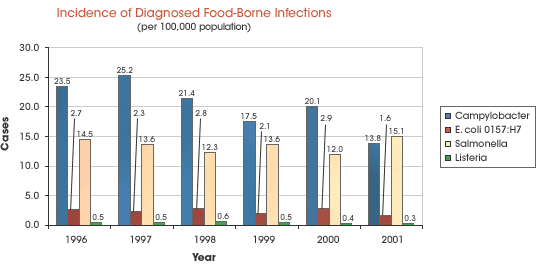
One of the deadliest food-borne illness outbreaks in the U.S. happened in late 1998. In November of that year, the CDC received several reports of listeria infections and traced them back to what it suspected were the sources of the bacteria: hot dogs from Bil Mar Foods, the country's biggest distributor of packaged meats and a division of Sara Lee Corporation. The CDC then took
its evidence to the USDA, which questioned whether it was enough to implicate Bil Mar. The USDA allowed Bil Mar to release a tepid consumer warning that had no mention of the deaths and serious illnesses. Consumers, meanwhile, continued to eat the tainted meats. Ultimately, the
CDC's suspicions were confirmed; the tainted meat did in fact originate from Bil Mar. In the end, the CDC traced 21 deaths -- 15 adults and 6 children -- and more than 100 illnesses to the outbreak.
According to a March 2000 report issued by the CDC, the number of food-borne illness outbreaks reported to the CDC remained relatively steady between 1993 and 1997. In 1993, the same year that an E. coli outbreak at the Jack in the Box hamburger chain claimed the lives of four children, there were 489 food-borne illness outbreaks. Four years later, there were yet more -- 504 reported outbreaks. Overall, there were 2,751
outbreaks of food-borne disease between 1993 and 1997, resulting in more
than 86,000 illnesses and 29 deaths. (See this chart for the number of outbreaks attributed to four of the most commonly found food-borne pathogens.)
In 1998, five years after the E. coli outbreak at Jack in the Box, the
CDC finally completed work on PulseNet, a national computer network of health
laboratories and its most potent weapon in the fight against outbreaks of
food-borne illnesses. Madeline Drexler, author of Secret Agents: The
Menace of Emerging Infections, says that PulseNet is the "public health
version of the FBI's 10 Most Wanted List, except that it features thousands
of microbial criminals." The laboratories in the network use a method
called pulsed-field gel electrophoresis (PFGE) to identify a bacterium's
DNA "fingerprint." The fingerprint is then entered into PulseNet's
electronic database, where it is compared to other bacteria DNA. Lookalike
patterns may indicate that samples hail from a common source.
While PulseNet has helped epidemiologists connect the dots between
disparate cases and to identify smaller outbreaks, it is unclear whether it
has led to a decrease in the number of actual cases of food-borne
illnesses. According to CDC data, between 1996 and 2000, the incidence of campylobacter, listeria, and salmonella infections decreased in the reporting areas, whereas the incidence of E. coli O157:H7 increased.
(See this chart for details.)


SOURCE: "Surveillance for Foodborne Disease Outbreaks: United States, 1993-1997," CDC, March 17, 2000.


SOURCE: "Preliminary FoodNet Data on the Incidence of Food-borne Illnesses Selected Sites, United States, 2000," from the CDC's Food-borne Diseases Active Surveillance Network (FoodNet), April 6, 2001.

home + industrial meat + interviews + the politics of meat + is your meat safe? + the inspection system
inside the slaughterhouse + producer chat + introduction + discussion + video
tapes & transcripts + press reaction + credits + privacy policy
FRONTLINE + wgbh + pbsi
web site copyright WGBH educational foundation
 |  |